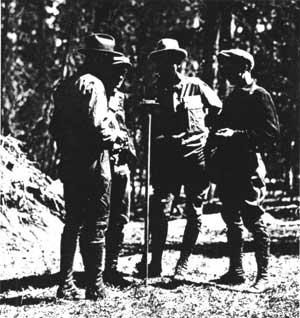Keen took over the control work at Crater Lake in late summer 1929 and prepared a report [18] of the activities that year that was more comprehensive than Patterson’s cursory report prepared just before he resigned in July. Keen, as a newcomer, took the first broad ecological look at the results of past control efforts and objectives of the current control work, and presented three alternative plans for future control.
Keen concluded that treatment reduced tree losses from pine beetles on areas treated and it reduced fire hazard, but that it had failed to exterminate the beetles in the park. He further recognized that as long as beetle outbreaks were widespread and surrounding the park there would be continued reinvasion of treated areas from these sources. Keen pointed out that protecting trees solely for aesthetic value was not appropriate because, in the course of stand succession, other species of conifers would replace the dead lodgepole. Here he erred because many of the infested stands were already climax lodgepole and would not be replaced by fir or hemlock. Keen thought that reducing the fire hazard was the only justification for spending such large sums of money on beetle control. He did not comprehend, however, that dead trees create fuel for subsequent wildfire, which initiated the development of new lodgepole pine stands, thus perpetuating this fire-maintained species.
Keen presented three plans for consideration by the Park managers (see footnote 18).
Plan 1. Intensive control work on all the areas infested at the present time, with the idea of eliminating the beetles from the Park areas and saving the remaining lodgepole forests.
To stand a reasonable chance of succeeding, this plan would have to take into account all the adjacent infestation within a radius of twenty-five or thirty miles (since it has been established beyond a reasonable doubt that these beetles may travel for such distances). This would involve the tremendous infestations north of the Lake on the Deschutes and Umpqua National Forests and require the cooperation of the Forest Service in controlling all such infestations in the general vicinity, while within the Park boundaries alone 25,000 to 30,000 acres of lodgepole would have to be combed carefully for infestations and all infested trees treated. To attempt this would require an expenditure of at least $25,000 of Park funds for the fiscal year 1930 and at least half this amount for several years to come. The plan would represent a commendable effort on the part of the Park Service to preserve the lodgepole forests but is doomed to defeat; for it is impossible to eliminate the beetles from such a large area, and sooner or later these stands are due to die and be replaced by other types. The plan is not only futile but would be tremendously expensive.
Plan 2. Control only along the roads in areas of high fire hazard and on recreational areas.
This plan would confine the work to areas on which most of the previous control work has been done, and would mean recleaning these areas for several years until the peak of the present epidemic has passed. It could be carried out with minimum expense and without involving the cooperation of adjacent owners. It would serve the purpose of reducing the fire hazard in areas of high risk and avoid unsightly dead forest areas along the main traveled roads. This plan could be carried out for the fiscal year 1930 with an expenditure of not over $5,000 and about half this amount for the next three or four years.
Plan 3. To do no control work.
If this course is followed the epidemic will soon die out for lack of suitable host material, as another three or four years will see the end of the present mature lodgepole stands in the Park. While this is the cheapest and easiest course to follow, it will leave a very unsightly mess along some of the roads and a bad fire hazard in the very places where fires are most apt to occur.
|
|
Keen recommended a continuation of the protection of valuable areas under plan 2 as the most feasible (see footnote 18).
Some of Keen’s analyses of the situation were perceptive and ahead of his time. But it would be 30 to 40 years before many forest managers recognized the futility of trying to control mountain pine beetle in dense, overmature lodgepole pine stands.


